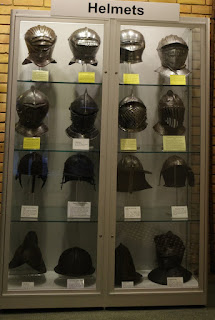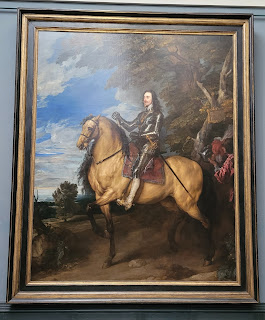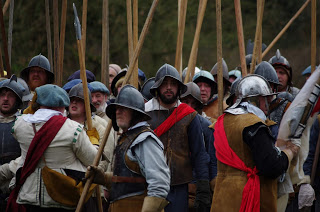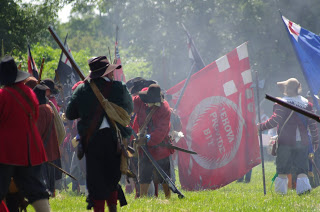Warlord Pike and Shotte Epic Battles: the Scottish sprue
Another 'freebie'* with this month's edition of Wargames Illustrated, so I thought it was my duty to pick up a copy and review them. Hopefully, my latest review of an Epic product won't generate the hate mail that my original posts did.
Warlord's Epic Pike and Shotte is, let's be honest, a bit of a Marmite thing (you either love it, or hate it). I probably fall between the two camps: a bit disappointed with the figures, specifically the cavalry sprue; yet hopeful that other manufacturers will produce stuff to support the range; and, of course I am all for a new range of 'true 15mm'** figures that covers my favourite period (particularly from a company with the 'reach' of Warlord Games).
This is, by necessity, a one sprue fits all solution, so combines, foot, artillery, dragoons and horse.
Let's look at the sprue in detail. The Epic look is not for everyone, but the foot strips are crisply detailed, no strange hands on pikes this time (maybe Warlord do listen and take on board reviews). Each sprue has four strips of lowland musketeers (all with musket rests, and still too closely spaced), three pike strips, and a command strip. There are no pikemen in the at port position, as with the generic infantry sprue. For those of you who want a generic look for their regiments of foot and are on the hunt for compatible Scots lowland pike 'at port', well rejoice as Peter Pig have just created such a figure.
 |
| Command |
 |
| Pike |
 |
| Muskets |
The artillery are nice, two individual gun crew figures, and two guns - a particularly nice frame gun, and a distinctly average organ gun. For those of you wanting to use the sprue for the Scots who ventured south into England, you'll need to supplement this ordinance with some heavier guns (the Covenanter army had possibly the largest artillery park out of all the armies fighting the Wars of the Three Kingdoms).
 |
| Artillery, two part frame gun far left, organ gun central |
There are five individual musketeers on foot: three of which look to be dragoons on foot (they are wearing short boots), and two 'commanded shot' figures (not wearing boots).
This sprue differs from the generic sprues in that the horse are located on this sprue too. There are two lancers, two mounted dragoons, and a mounted commander/ generic Scottish cavalry man. Scottish cavalry was a broader church than either the Royalist or Parliamentarian armies: horses tended to be smaller, hardier breeds than those found in England. So unarmoured lancers, unarmoured harquebusier type troops, with just a smattering of conventional harquebusiers.
 |
| top row: dragoons, bottom row: lancers, middle/right: generic/commander |
Warlord, have again appeared to have listened to the criticism of their cavalry sprue, as the front and back detail on the riders is more evident with these sculpts, mould lines still very visible though. Side on detail is nice and crisp though. No cornet figure or trumpeter, although there is a separate trumpet. The mounted figures are a vast improvement upon the figures on the cavalry sprue, but the production method means that they will always be a poor second to metal figures.
 |
| l-r, dragoons x 2, lancers x 2, generic cavalry/commander |
Overall I quite like the figures on the sprue, but the 'one sprue fits all' will cause a few problems for those of you trying to build an Army of the Solemn League and Covenant. You are going to end up with far too many dragoons than were ever fielded, not enough cavalry (and no cavalry command), and your artillery park will be seriously lacking heavier guns.
For those of you new to KeepYourPowderDry, you can find out more about Epic Pike and Shotte here (including which other manufacturer's ranges work well with Epic, headswaps and a general painting guide); specific painting guides to Scottish troops here and here; more about my Covenanter Army here, and my Montrose Royalist Army here. If you want to know what colour to paint sashes scarves you'll find that here. If you want to know lots more about the English Civil War, and why it is more accurately called the Wars of the Three Kingdoms, without spending an arm and a leg on books see here.
Wargames Illustrated give a handy painting guide, which strangely doesn't mention the words 'hodden grey', and gives a grey and blue palette for coats instead; it also has good tips on painting tartan (which is a really problematical subject - it didn't exist in the 'Edinburgh Royal Mile gift shop' sense that we think of tartan today, there weren't specific clan tartans yet, and brightly coloured checked pattern cloth was generally the preserve of the very wealthy).
WI also gives advice on how to make Covenanter flags. Please note that the proclamation changed depending upon the year: 1639 For Christs Croun and Covenant, or For Religion the Covenant and the Country; by 1644 this had become For the Covenant Religion the Crown and the Kingdom; by the time of Dunbar it had become Covenant Religion King and Kingdomes. As was the European tradition, the colonel's colour would be white, usually with an emblem from his coat of arms dominant; the rest of the colours were usually a variation upon St Andrew's saltaire; there does seem to have been a regional distribution of colour schemes. There were instances of signifiers for different companies - either an increasing number of emblems, or numbers.
* Not really free, you have to buy the magazine; as I wouldn't normally buy the magazine, I'm guessing I bought the sprue, and got a free magazine
** Warlord might be calling them 'Epic scale' but they are, let's be honest here, true 15mm.












An excellent and rational review as ever.
ReplyDeleteThanks Dex
DeleteThank you for an excellent review. I picked up the magazine and for some reason was quite taken with the little fellows, I went back the next day to get another issue (as it's cheaper than buying from Warlord!) and was frustrated to find the shop had rolled over to the next month and they were all gone :-( I've started painting them and they take Citadel Contrast paints brilliantly. Anyway, I wonder what you think about the ratio of Pike to Shot? Warlord product shots show the Musketeers in only 2 ranks but the Pikes in 4, why is that? My understanding, from my limited sources, is that they were normally both in the same depth (6 or 8 ranks).
ReplyDeleteThanks for your kind words.
DeleteThe pike to shot ratio is technically incorrect. The historical aim was 2 muskets to 1 pike. How often that was achieved, we don't really know. We know a few individual regimental ratios, but in reality we don't know.
The deeper pike block is a Wargamer thing, probably dating back to the Gush rules.
Warlord have taken a similar stylistic approach to my own regiments of foot - Sturt's plan of Naseby being the 'look' that we both want to achieve. I've gone for threw rows of pikes, two of muskets, a row of halberdiers behind the muskets, and a command stand in front/behind the pike block. Perhaps I should have copyrighted the look, as Warlord are dangerously close to copying! I am tempted to add a third row of musketeers to all my regiments, but the thought of painting 3 or 400 musketeers (and all the headswaps) is a big deterrent.
At the end of the day, it's a pastiche. Is it accurate? - probably not, does it look good? - only you can answer that one.
The main attraction of these plastic miniatures to me is the fact that it should be possible to get closer to that contemporary Naseby look. But to do that, you would need 4 or 5 model ranks of both pike and shot. And, as you say, some officers/NCOs with pole-arms stood apart from the blocks. I naively thought the plastic rows of men would be both easy to paint and cheap to buy, so you could build those dream units. If I have to base them with the same compromises as larger ‘conventional’ models, then I’m wondering what the point is? I’m currently thinking of trying 60mm x 60mm bases with 4 rows of pikes and a single halberdier, or 3 rows of muskets, again with a single halberdier. This would mean buying three sprues to field two units, to get enough musketeers, and it also assumes I can work out how to paint them quicker!
DeleteBut there’s another wargamer’s dilemma to solve - do I need to support sub-unit bases, for changes of formation? For example, do the pikes need to be able to extend their frontage (and halve their depth) to better protect the musketeers from cavalry? If the musketeers send out a party of commanded shot, do I need to represent that as a thinning of the main formation? It’s quite a complicated period.
From my own experience of painting them, treat them as 'flats'. Once you have worked out what everything is, they should be quick and easy to paint.
DeleteThere are a couple of metal ranges which marry nicely with the Epic range - useful source of halberdiers, extra pike and musketeers too.
Have a look at my other posts tagged 'Warlord' for comparison with other ranges, painting tips, and a guide to the equipment on the figures.
Basing dilemmas? All I can suggest is that you have a look at how I have approached basing my RoF. Perhaps that might help you formulate your own plan?
Good luck with your project
Thanks for the tips!
DeleteHi, not sure where to post this but since you reviewed the Montrose Scots set and have been extremely thorough and thoughtful in your past review of the Epic Pike and Shotte product line, wanted to flag that the actual set, as shipped in the US, fails to include the advertised resin plus highlander figures. You'll see those advertised on the exterior packaging, the manufacturer's product announcement website, the Warlord Games' owner's own unboxing video (time stamp minute 2:46 and following here: 2:46):
ReplyDeletehttps://www.youtube.com/watch?v=SX4y7KGuiNo) but what you actually get is some badly misshapen and ill produced pewter figures that obscure most of the advertised detail. Photos here:
- https://i.ibb.co/MpWjg2V/IMG-7929.jpg
- https://i.ibb.co/QKZt9dm/IMG-7928.jpg
And here's what they expressly advertise: https://i.ibb.co/p3pmrJx/Montrose-advertised.jpg
I've written to the manufacturer to inquire about this production fault, but in the meantime would advise people in the US to not buy this, since there appears to be a confusion of manufacturing lines.
Hi Windjammer, those really don't look good at all. I hope Warlord fix the issue to your satisfaction.
DeleteIn fairness to Warlord, as a 'right to reply', please post any follow ups here.
Good luck!
Thank you and yes I'll definitely post an update. For transparency and easier viewing, I've also posted this with images on the Warlord Games sub-reddit. Link here: https://www.reddit.com/r/warlordgames/comments/1hrf8gj/warlord_moves_epic_pike_shotte_to_pewter_with/
Delete